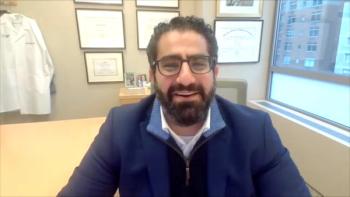
TMB May Predict Success of Chemoradiation, Durvalumab in Locally Advanced NSCLC
The findings on tumor mutational burden (TMB) may fill a gap in biomarkers for patients who have non–small cell lung cancer (NSCLC).
A high tumor mutational burden (TMB) appears to be a meaningful biomarker for superior outcomes in patients with locally advanced non–small cell lung
The findings could make it easier for clinicians to personalize care and decide upon treatment pathways for patients with the cancer type.
The authors said recent evidence suggests including the monoclonal antibody durvalumab as consolidative therapy with concurrent chemoradiation therapy (cCRT) can improve disease control and survival among people with locally advanced NSCLC.
“However, there remains a need to identify biomarkers for response to this therapy to allow for risk adaptation and personalization,” they wrote.
Previous research has shown that patients with high TMB benefit from immune checkpoint inhibitors (ICIs), and other evidence suggests TMB might be a biomarker for radiation sensitivity.
“However, TMB has yet to be robustly assessed in patients with locally advanced disease treated with cCRT and durvalumab,” they said.
The investigators wanted to know whether TMBor other variables associated with radiation response might also be predictive of outcomes following chemoradiation and durvalumab in patients with locally advanced unresectable NSCLC.
The team analyzed a cohort of 81 consecutive patients who underwent chemoradiation with durvalumab for locally advanced unresectable NSCLC between November 2013 and March 2020. Patients were included in the study only if they had prospective comprehensive genomic profiling. The patients were grouped based on their TMB status, with atleast 10 mutations/megabase serving as the cutoff point between the TMB-high group (36 patients) and TMB-low group (45 patients). Participants were also evaluated for somatic alterations associated with radiation resistance or sensitivity.
After a median follow-up of 26 months, the investigators looked at patient outcomes, focusing on local-regional failure (LRF) and progression-free survival (PFS).
The data showed that people with high TMB had significantly better outcomes than those with low TMB. The high-TMB group had a 24-month LRF rate of just 9% (95% CI, 0%-46%) compared with 51% in the low-TMB group (95% CI, 36%-71%). In terms of survival, 66% of people in the high-TMB group achieved PFS at 24 months (95% CI, 54%-84%; P = .001) compared with 27% in the low-TMB group (95% CI, 13%-40%; P = .003).
The data also suggested that patients with traits associated with radiation resistance (KEAP1/NFE2L2-altered tumors) had higher rates of LRF vs patients who did not have those alterations. However, a Cox analysis found only TMB status was significantly associated with LRF and PFS. Other factors, including histology, disease stage, and programmed cell death-ligand 1 expression did not have a statistically significant association with patient outcomes, they found.
The investigators said there are several reasons why TMB status would be linked with patient outcomes.
“High TMB levels have been associated with alterations in [DNA damage repair] genes, and given their role in radiation repair, a finding of improved LRF outcomes in TMB-high tumors would be logical,” they wrote.
Such alterations might also play a role in increasing sensitivity to ICIs, they noted.
The investigators concluded that TMB appears to be a “promising biomarker for guiding trials of personalized therapy approaches, including intensification of therapy for high-risk patients and deintensification of therapy for low-risk patients with stage III NSCLC.”
Reference
Lebow ES, Shepherd A, Eichholz JE, et al. Analysis of tumor mutational burden, progression-free survival, and local-regional control in patients with locally advanced non–small cell lung cancer treated with chemoradiation and durvalumab. JAMA Netw Open. Published online January 3, 2023. doi:10.1001/jamanetworkopen.2022.49591
Newsletter
Stay ahead of policy, cost, and value—subscribe to AJMC for expert insights at the intersection of clinical care and health economics.















































